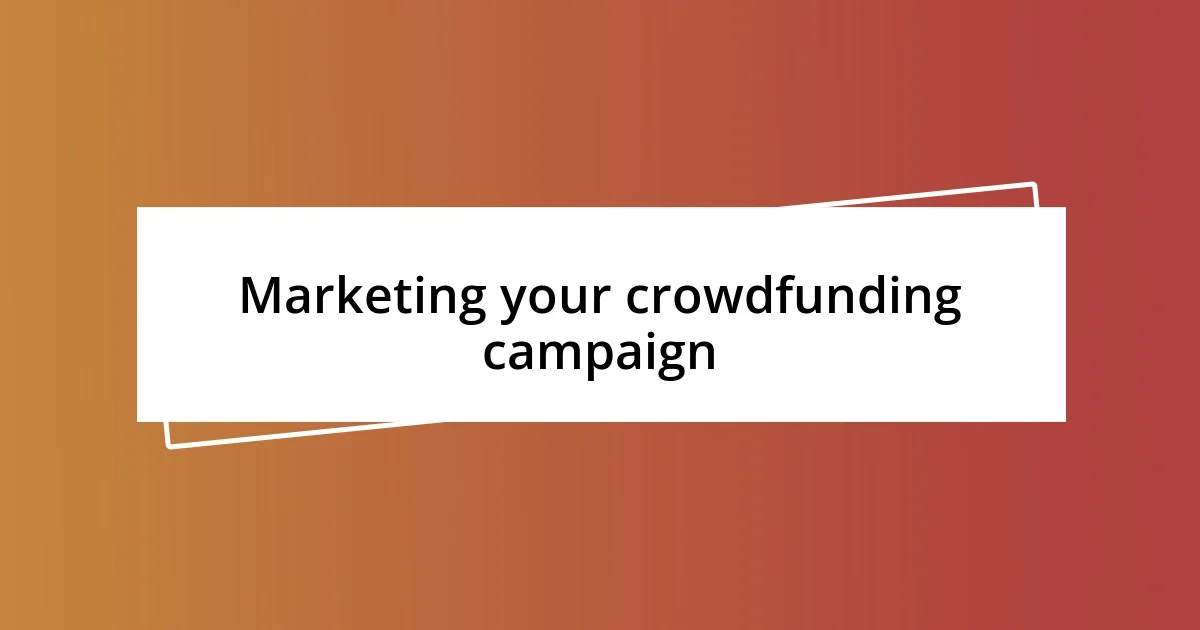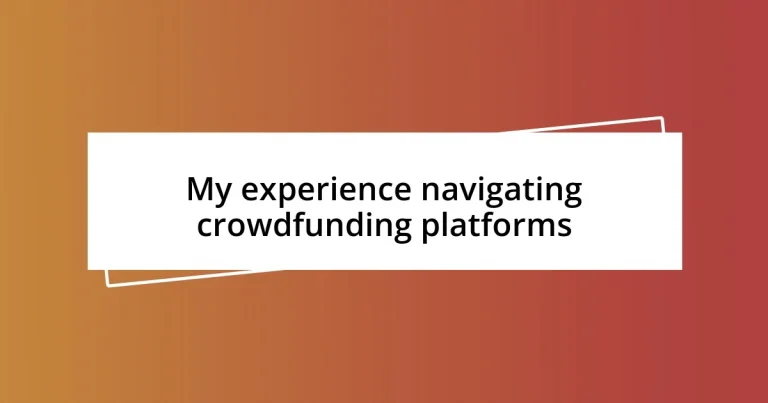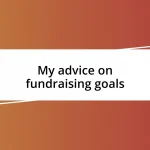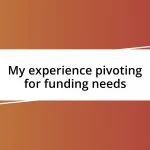Key takeaways:
- Choosing the right crowdfunding platform is crucial; align your project’s mission with the platform’s focus and audience for better engagement.
- Setting clear fundraising goals and breaking them into manageable milestones is essential for motivating backers and tracking progress.
- Engaging effectively with backers through genuine connections, gratitude, and feedback fosters loyalty and enhances the overall campaign experience.

Overview of crowdfunding platforms
Crowdfunding platforms have transformed the way individuals and businesses fund their projects, allowing people to turn their dreams into reality with just a click. I still vividly remember the excitement I felt when my own project caught the attention of backers online; it was as if I had unlocked a door to a world filled with possibilities. But just how many platforms are out there, and how do you choose the right one for your idea?
Each crowdfunding platform has its unique vibe and audience. For instance, platforms like Kickstarter are often geared toward creative projects, while GoFundMe targets personal causes and charitable endeavors. I once spent hours exploring various sites before deciding on one, overwhelmed by the sheer number of options. It’s an emotional rollercoaster, isn’t it? You want to ensure your project resonates with the right crowd, but how do you know where your vision belongs?
As I navigated the platforms, I learned that understanding their fee structures and reward systems is crucial. Some platforms take a percentage of funds raised, while others charge upfront fees. This kind of information can make or break your funding journey. Reflecting back, how do you measure the value you get in return for your hard work and creativity? It’s all about strategic planning, and I found that each detail matters when you’re putting your heart and soul into something you believe in.

Choosing the right crowdfunding platform
When I was selecting a crowdfunding platform, I realized that alignment with my project’s mission was paramount. For instance, platforms geared toward tech innovations might not attract the same crowd as those focused on creative arts. I remember feeling a rush of hope when I finally found a platform that seemed to resonate with both my vision and values; the right fit just felt like destiny.
Another critical aspect for me was understanding the platform’s audience. I learned that each platform has a different demographic and it’s essential to connect with supporters who genuinely believe in what you’re creating. Once, I watched a successful campaign thrive simply because the creator had tapped into a community that was already passionate about similar projects. It made me appreciate the power of not just the idea, but the audience behind it.
Lastly, I can’t stress enough the importance of transparency in fees. Some platforms quietly deduct higher percentages than you expect, significantly impacting your final funding. I found myself navigating the fine print, feeling a mix of anxiety and determination as I calculated how much I might lose. It’s an exhilarating yet cautious approach—research is your ally in ensuring your hard-earned funds are protected.
| Platform | Focus |
|---|---|
| Kickstarter | Creative Projects |
| GoFundMe | Personal Causes |
| Indiegogo | Flexible Funding for Various Projects |
| Patreon | Ongoing Support for Creators |

Setting clear fundraising goals
Setting clear fundraising goals transforms your crowdfunding experience. When I was starting out, I made the mistake of thinking any amount would be sufficient to kick things off. After rearranging my strategy, I realized a well-defined target not only motivated potential backers but also provided a measurable path to success. It’s like setting a destination before embarking on a journey; if you don’t know where you’re going, how will you navigate there?
To effectively set those fundraising goals, consider these factors:
- Project Costs: Calculate the total expenses involved, from production to shipping.
- Marketing Expenses: Factor in costs for promoting your campaign to reach a wider audience.
- Platform Fees: Don’t forget the fees associated with your chosen crowdfunding platform.
- Buffer Amount: Add a cushion for unexpected costs; I learned the hard way that surprises often arise.
- Milestones: Break down your overall goal into smaller, achievable milestones to maintain momentum and enthusiasm among your supporters.
When I finally set my goal, I chose a figure that felt ambitious yet attainable. The support I gained—seeing those early backers contribute—was like adding fuel to my fire. It motivated me to push harder and engage with my community more deeply. Crafting clear goals not only laid the foundation for my campaign but also created a sense of accountability, making me feel like I was not just chasing a number but realizing a vision.

Building a compelling campaign story
Crafting a compelling campaign story is about positioning your project as a solution to a problem or a vehicle for change. In my experience, sharing a personal journey often resonates deeply with potential backers. For instance, when I was launching my campaign, I wrote about the challenges I faced leading to my project’s creation. It wasn’t just a mundane backstory; I shared the emotional highs and lows, and I could see people’s eyes light up as they connected with my struggle. Have you ever felt that surge of empathy when someone shares their truth? That’s the magic I aimed to create.
I also learned that visuals can amplify your narrative. Including authentic images and videos can be the difference between a brief glance and a committed backer. I made sure to capture candid moments while working on my project, which painted a vivid picture of the hard work and passion involved. Seeing my dedication in action—even in simple photos—allowed supporters to feel like they were part of my creation process. It makes me wonder: what stories do your visuals tell?
Lastly, integrating a clear call to action within my story was crucial. While I was keen on sharing my journey, I made sure it didn’t end there. I explicitly invited my audience to be part of my mission. I remember crafting a closing line that urged potential backers to lend their support, not just as financial contributors but as collaborators in a shared vision. It was a moment of vulnerability that I believe drew people in. Think about your own campaign: how can you encourage others to join you on this journey?

Marketing your crowdfunding campaign
Marketing your crowdfunding campaign is often just as critical as the campaign itself. I can’t stress enough how much I leaned on social media platforms to create buzz around my project. Initially, I shared updates with my friends and family, but soon I realized that reaching a broader audience required consistent and targeted engagement. Have you thought about how social channels could amplify your message? By strategically using hashtags and joining relevant groups, I expanded my reach tremendously, ultimately connecting with people who genuinely aligned with my mission.
During my campaign, I organized online events, including live Q&A sessions. This hands-on approach allowed potential backers to interact with me directly, asking questions and expressing their excitement. I’ll never forget the sense of community that emerged from those sessions; the energy was palpable! Engaging your audience through interactive experiences not only builds trust but also fosters a deeper connection—something I found crucial when it came to turning interest into actual support. How can you create moments of connection in your own campaign?
Additionally, I found that leveraging email marketing was a game-changer. I created a mailing list even before launching, which allowed me to nurture relationships with early supporters. I frequently sent out updates, sneak peeks, and personal thank-you notes to keep them excited. One memorable moment was when I sent an update video that showcased behind-the-scenes work. The personal touch sparked conversations and made my backers feel valued. Have you taken the time to connect with your supporters on a more personal level? Your campaign will thrive when your backers feel like they’re part of something special.

Engaging with backers effectively
Engaging with backers effectively is about fostering genuine connections. I remember a moment during my campaign when I took the time to respond to every single comment and message I received. Some of these backers had questions that weren’t just about the project; they shared their personal stories, and I realized that they weren’t just checking in; they were looking to connect. I felt a responsibility to acknowledge their support and build a rapport. How much more invested do you think my backers felt when they knew I was listening to them?
Another aspect that really stood out for me was the power of gratitude. I made it a point to send personal thank-you messages to backers, even for smaller contributions. One backer reached out to me after receiving my thank-you note, expressing how much it meant to him. This made me realize that little gestures can transform a simple transaction into a meaningful interaction. Have you thought about how your appreciation can deepen the relationship with your supporters?
Moreover, I learned that engaging backers is a two-way street. While I wanted to share my vision, I also encouraged backers to share their ideas and feedback. I set up a dedicated space on my campaign page where they could voice their opinions. The input I received was invaluable, and it made everyone feel like they had a say in shaping the project. Wouldn’t it be amazing to create an atmosphere where your backers not only support you but actively contribute to the project’s direction?

Evaluating campaign success and feedback
Evaluating the success of my crowdfunding campaign was an eye-opener. I relied heavily on metrics like funding progress and backer engagement. Seeing those pledge numbers rise was exhilarating, but what truly mattered to me was the feedback from my supporters. One comment stood out, where a backer expressed how inspired they felt by my story. Moments like that made me realize that success isn’t just about dollars; it’s about impact. Have you ever contemplated how qualitative feedback can inform your project’s next steps?
I also established a feedback loop by following up with my backers post-campaign. I sent out surveys asking what they appreciated and what could have been better. The responses were insightful and sometimes surprising! For instance, some backers suggested enhancing the visual elements of my campaign. Their input helped me see my project through their eyes, reinforcing the idea that I needed to stay open to constructive criticism. Isn’t it fascinating how an outsider’s perspective can reignite your passion and improve your approach?
In the end, I learned that evaluating campaign success isn’t merely a numbers game. It requires an emotional attunement to your community. After all, my campaign was built on relationships, and understanding the sentiment behind my backers’ words helped me grow as a creator. Isn’t it rewarding when supporters feel valued enough to share their thoughts and experiences? Engaging with their feedback cultivated a sense of loyalty that I never expected but deeply cherished.














